The Crucial m4 (Micron C400) SSD Review
by Anand Lal Shimpi on March 31, 2011 3:16 AM ESTRandom Read/Write Speed
The four corners of SSD performance are as follows: random read, random write, sequential read and sequential write speed. Random accesses are generally small in size, while sequential accesses tend to be larger and thus we have the four Iometer tests we use in all of our reviews.
Note that we've updated our C300 results on our new Sandy Bridge platform for these Iometer tests. As a result you'll see some higher scores for this drive (mostly with our 6Gbps numbers) for direct comparison to the m4 and other new 6Gbps drives we've tested.
Our first test writes 4KB in a completely random pattern over an 8GB space of the drive to simulate the sort of random access that you'd see on an OS drive (even this is more stressful than a normal desktop user would see). I perform three concurrent IOs and run the test for 3 minutes. The results reported are in average MB/s over the entire time. We use both standard pseudo randomly generated data for each write as well as fully random data to show you both the maximum and minimum performance offered by SandForce based drives in these tests. The average performance of SF drives will likely be somewhere in between the two values for each drive you see in the graphs. For an understanding of why this matters, read our original SandForce article.
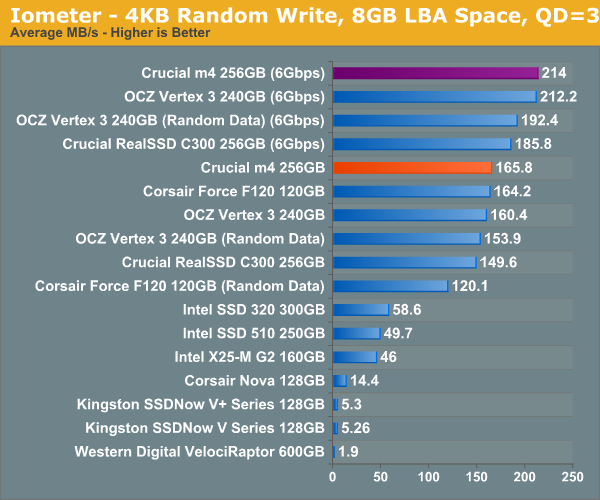
If there's one thing Crucial focused on with the m4 it's random write speeds. The 256GB m4 is our new king of the hill when it comes to random write performance. It's actually faster than a Vertex 3 when writing highly compressible data. It doesn't matter if I run our random write test for 3 minutes or an hour, the performance over 6Gbps is still over 200MB/s.
Let's look at average write latency during this 3 minute run:
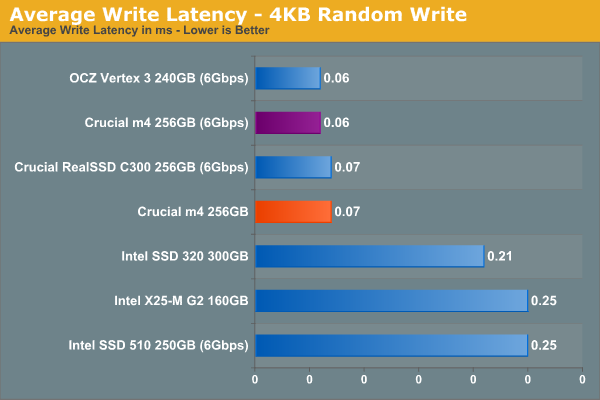
On average it takes Crucial 0.06ms to complete three 4KB writes spread out over an 8GB LBA space. The original C300 was pretty fast here already at 0.07ms—it's clear that these two drives are very closely related. Note that OCZ's Vertex 3 has a similar average latency but it's not actually writing most of the data to NAND—remember this is highly compressible data, most of it never hits NAND.
Now let's look at max latency during this same 3 minute period:
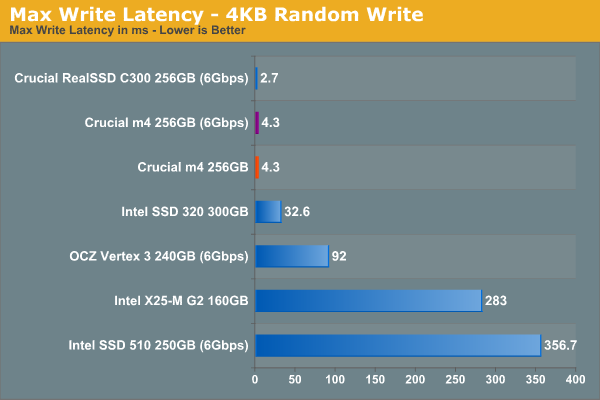
You'll notice a huge increase in max latency compared to average latency, that's because this is when a lot of drives do some real-time garbage collection. If you don't periodically clean up your writes you'll end up increasing max latency significantly. You'll notice that even the Vertex 3 with SandForce's controller has a pretty high max latency in comparison to its average latency. This is where the best controllers do their work. However not all OSes deal with this occasional high latency blip all that well. I've noticed that OS X in particular doesn't handle unexpectedly high write latencies very well, usually resulting in you having to force-quit an application.
Note the extremely low max latency of the m4 here: 4.3ms. Either the m4 is ultra quick at running through its garbage collection routines or it's putting off some of the work until later. I couldn't get a clear answer from Crucial on this one, but I suspect it's the latter. I'm going to break the standard SSD review mold here for a second and take you through our TRIM investigation. Here's what a clean sequential pass looks like on the m4:
Average read speeds are nearing 400MB/s, average write speed is 240MB/s. The fluctuating max write speed indicates some clean up work is being done during the sequential write process. Now let's fill the drive with data, then write randomly across all LBAs at a queue depth of 32 for 20 minutes and run another HDTach pass:
Ugh. This graph looks a lot like what we saw with the C300. Without TRIM the m4 can degrade to a very, very low performance state. Windows 7's Resource Monitor even reported instantaneous write speeds as low as 2MB/s. The good news is the performance curve trends upward: the m4 is trying to clean up its performance. Write sequentially to the drive and its performance should start to recover. The bad news is that Crucial appears to be putting off this garbage collection work a bit too late. Remember that the trick to NAND management is balancing wear leveling with write amplification. Clean blocks too quickly and you burn through program/erase cycles. Clean them too late and you risk high write amplification (and reduced performance). Each controller manufacturer decides the best balance for its SSD. Typically the best controllers do a lot of intelligent write combining and organization early on and delay cleaning as much as possible. The C300 and m4 both appear to push the limits of delayed block cleaning however. Based on the very low max random write latencies from above I'd say that Crucial is likely doing most of the heavy block cleaning during sequential writes and not during random writes. Note that in this tortured state—max write random latencies can reach as high as 1.4 seconds.
Here's a comparison of the same torture test run on Intel's SSD 320:
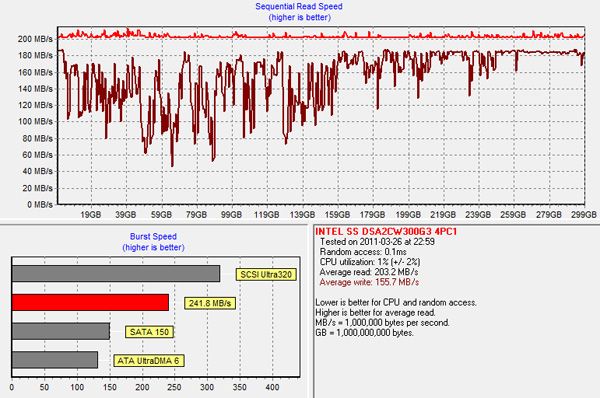
The 320 definitely suffers, just not as bad as the m4. Remember the higher max write latencies from above? I'm guessing that's why. Intel seems to be doing more cleanup along the way.
And just to calm all fears—if we do a full TRIM of the entire drive performance goes back to normal on the m4:
What does all of this mean? It means that it's physically possible for the m4, if hammered with a particularly gruesome workload (or a mostly naughty workload for a longer period of time), to end up in a pretty poor performance state. I had the same complaint about the C300 if you'll remember from last year. If you're running an OS without TRIM support, then the m4 is a definite pass. Even with TRIM enabled and a sufficiently random workload, you'll want to skip the m4 as well.
I suspect for most desktop workloads this worst case scenario won't be a problem and with TRIM the drive's behavior over the long run should be kept in check. Crucial still seems to put off garbage collection longer than most SSDs I've played with, and I'm not sure that's necessarily the best decision.
Forgive the detour, now let's get back to the rest of the data.
Many of you have asked for random write performance at higher queue depths. What I have below is our 4KB random write test performed at a queue depth of 32 instead of 3. While the vast majority of desktop usage models experience queue depths of 0—5, higher depths are possible in heavy I/O (and multi-user) workloads:
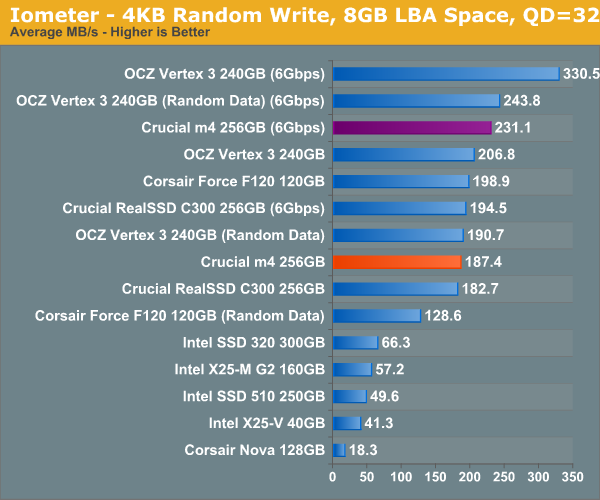
High queue depth 4KB random write numbers continue to be very impressive, although here the Vertex 3 actually jumps ahead of the m4.
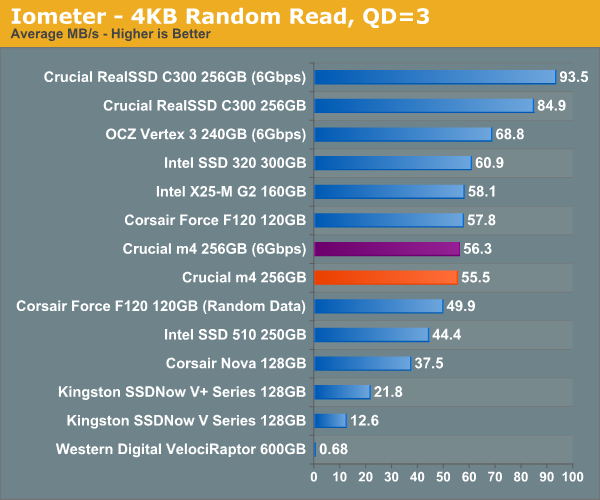
Random read performance is actually lower than on the C300. Crucial indicated that it reduced random read performance in favor of increasing sequential read performance on the m4. We'll see what this does to real world performance shortly.


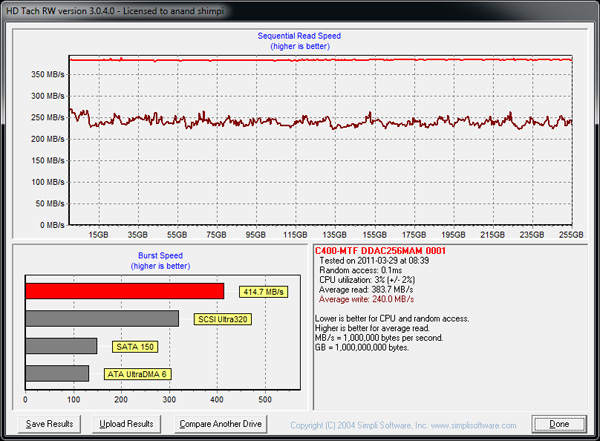
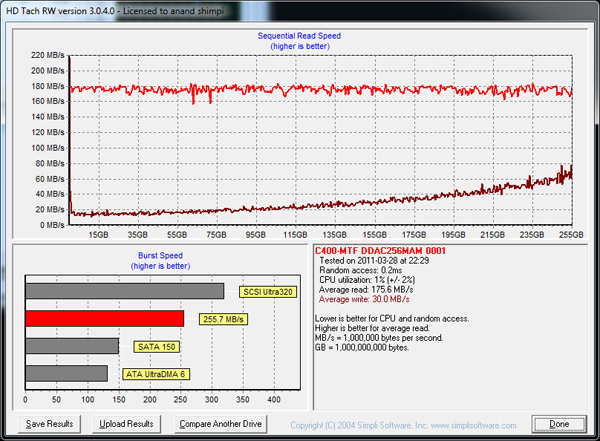
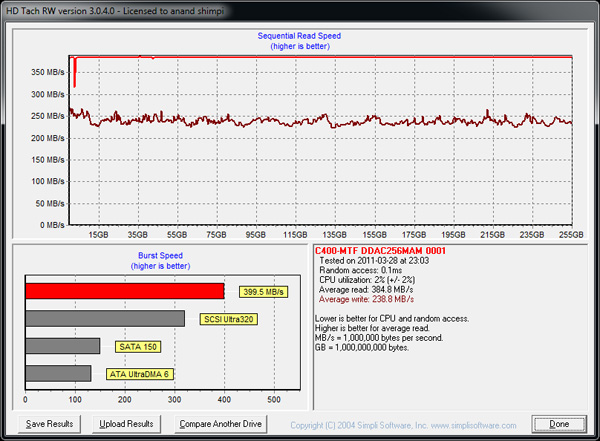








103 Comments
View All Comments
MrSpadge - Thursday, March 31, 2011 - link
Wait for the final hard- and software. Some power saving mode was probably not active in this beta version.MrS
Out of Box Experience - Friday, April 1, 2011 - link
The majority of users as of January 2011 were still using XP55% used XP
22% used Windows 7
So for the Majority of users, Intel's 320 series is still the best SSD to get as it uses the same OS agnostic controller that the last Intel SSD's
OCZ on the other hand just purchased Indilynx so we may yet see a OS agnostic controller from them in the near future to compete with Intel in the non-Windows 7 space
This would make perfect sense for OCZ to add the offset to Indilynx controllers to compete for XP users and keep the Sandforce line for Windows 7 users
Although Indilynx does not have the Raw throughput of a Sandforce SSD, it would give respectable performance on "ANY" OS without the need for partition hacks and should be suitable for dual boots if the proper offset is implemented
One of the most basic problems with partition offset hacks for XP was that the offset would be lost if you backup and restore a single partition using Acronis True Image
The only way to keep the offset would be to backup the entire drive!
O&O defrag Pro v14 has a "Manual" Trim command if anyone is interested ???
Controllers that do not include the proper offset for XP boxes generally have horrible "USED" performance after several writes but seem to function OK if you only use them for a boot drive and avoid writes (Hard to do with XP)
Out of Box Experience - Friday, April 1, 2011 - link
Correction:--------------
So for the Majority of users, Intel's 320 series is still the best SSD to get as it uses the same OS agnostic controller that the last generation Intel SSD's had
7Enigma - Friday, April 1, 2011 - link
Could you site your source for those numbers? My hunch is that the people still on XP are likely NOT the same people that will be purchasing these drives. More likely they are on Vista or Win7 which mainly negates your comment.Don't get me wrong I love XP still (my laptop and wife's computer are still running it), but for my main gaming rig (only system with a SSD) I've been through 2 OS revisions (Vista and now 7). Why? DX10/11 support.
And people upgrading existing systems for a SSD are likely upgrading for similar reasons. Few people are going to drop $100-400 for a SSD on a 3-5 year old computer. They are brainwashed into thinking the spyware/virii loaded system is slow because it's old, not because it just needs a fresh install and some proper lockdown/protection.
Out of Box Experience - Friday, April 1, 2011 - link
Sorry, I could not find the exact source that I used but here is a different one with similar resultshttp://www.winmatrix.com/forums/index.php?/topic/3...
Your hunch that people still using XP are likely NOT the same people that will be purchasing these drives is a good bet due to the fact that these drives tend to perform quit badly in a used state when compared to the Intel SSD's on an XP box
This is also the reason I think that OCZ may have purchased Indilynx
To add the offset needed to compete with Intel on the XP boxes
Even if Windows 7 had the same market share "TODAY" that XP enjoys, it is still foolish for SSD makers to ignore that huge XP market at their own detriment
Windows 7 may be the future, but there's gold in them thar XP hills
LeTiger - Thursday, March 31, 2011 - link
With the major players out of the woods now, I guess it's just time to wait until next year to see prices go down. Overall, I can't decide whether I'm happy over a (potentially) knockout performance by OCZ, or sad at the state of Intel/Crucial/etc... offerings...With prices where they still are at this point, I am very satisfied with my 30gb boot drive, and will continue to wait till costs go down until I convert fully over to the SSD realm...
Wave Fusion - Thursday, March 31, 2011 - link
I don't place much faith on that happening.SSDs are selling well enough there's not a good enough reason to reduce prices anytime soon.
At about $1 per GB most SSDs costs more than major parts like the CPU, GPU, RAM and HDD combined.
Allow me to pose a question for a general consensus: All and SSD does better is open files/programs faster and move large files (drive 1 to drive 2) faster; due to its high read/write speeds and more simultaneous operations.
BUT; if you've already run a program once since booting, closed it, then opened it again.. I thought the program was likely cached in the RAM. Which means an SSD would no longer improve anything
The only potential benefit past 1st run would be any data that's never rerun, like media encoding. But the often poorly designed/outdated single threaded programs themselves are a bottleneck way before a HDD is. At least on my machine, even similtaneous
So then I have to ask myself, assuming recently accessed files/programs cached in RAM isn't some myth; what do I really gain from using an SSD?
Why would I spend that money when I could instead use it for an even better GPU or something I actually will notice?
MilwaukeeMike - Thursday, March 31, 2011 - link
Valid point.. but when I use my PC i do a few things frequently that would benefit. I have a kid, and therefore lots of pics and videos, and i play some video games, so i deal with loading screens. I don't ever sit and wait and wish i had 100 FPS instead of my current avg 60. The only times i'm ever looking at my screen and waiting for my PC to finish doing something is either loading a webpage (1-2 seconds) or loading a game (often) or copying files (kinda rare).You're right, if you only use word and excel, this isn't for you. But if find yourself waiting for game screens to load it's worth it. Also, many people have already perfectly fast CPU's/GPU/s and good enough monitors.
The HD is the last slow piece of my computer for me to upgrade.
Ammaross - Thursday, March 31, 2011 - link
Yes, most CPUs bought within the last two years will be more than powerful enough to handle common use. Juicing a system with an SSD will be the best way to regain "lost" performance. Rather than telling your parents to get a new computer when their old one is just "too slow," upgrade their hard drive to an SSD. They likely don't reach 120GB as it is.LeTiger - Friday, April 1, 2011 - link
I would spend the money because for what I do, an SSD greatly benefits my workflow. Tooling around in Lightroom/CS5 all day benefits from an SSD. I just think they are still too much, and when they do get down to the $1 per gig, I will snatch up the biggest one I can afford.As far as "something you will actually notice", you couldn't be more mistaken, an SSD will make the biggest noticeable difference in performance in a computer that you will be able to see. As the comment below says, (and I agree), would you rather watch your FPS meter jump from 60 to 100? or have almost everything you do load very, VERY quickly.
- It made my intel Atom/ION laptop feel as fast as my Quad Core for light usage scenarios, now that is worth spending money on as peace of mind.